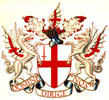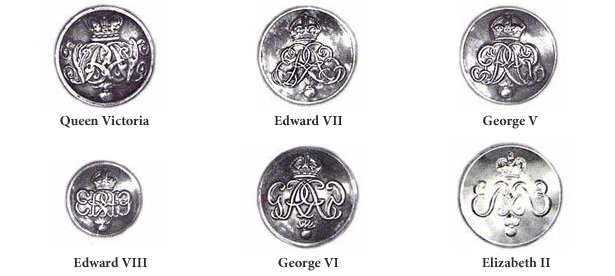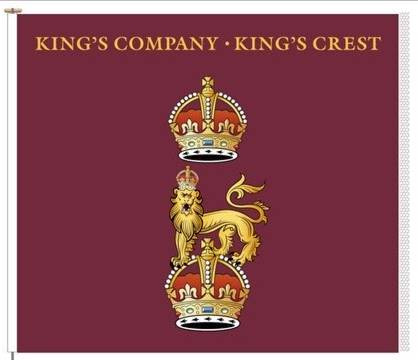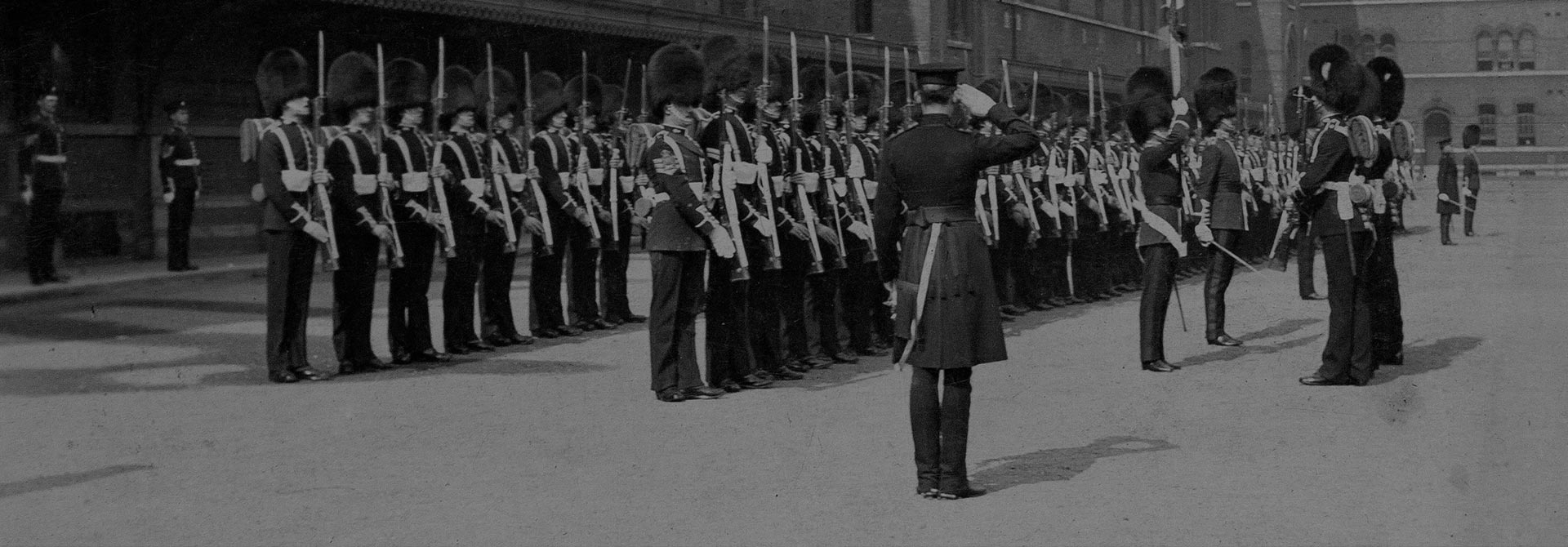Privileges
Those bestowed on the Regiment by cities
 All Battalions of the Regiment have the right to march through the City of London with Colours flying, drums beating and bayonets fixed. Battalions are invariably to exercise this right when marching through the City boundaries, but are to inform the Lord Mayor of their intention to do so. The right, formerly possessed by the 3rd Battalion only, was extended to the remaining Battalions of the Regiment in October 1915. The authentic challenge to a body of troops entering the City boundaries, and the reply, is:
All Battalions of the Regiment have the right to march through the City of London with Colours flying, drums beating and bayonets fixed. Battalions are invariably to exercise this right when marching through the City boundaries, but are to inform the Lord Mayor of their intention to do so. The right, formerly possessed by the 3rd Battalion only, was extended to the remaining Battalions of the Regiment in October 1915. The authentic challenge to a body of troops entering the City boundaries, and the reply, is:
- As the head of the Battalion approaches the City boundary, the City Marshal, mounted, stands in the middle of the road.
- The Commanding Officer halts the Battalion and then rides forward.
- The City Marshal then calls out "Who comes there?"
- The Commanding Officer replies "The First Battalion Grenadier Guards exercising their ancient privilege and right to enter the City of London with Colours flying, drums beating and bayonets fixed."
- The City Marshal replies "I have it on the authority of the Lord Maytor to receive and attend your Battalion through the City." He salutes and leads the Battalion through the City, past the Mansion House to the City boundary.
 On 4 March 1964, the Council of the City of Manchester resolved unanimously that the Council "place on record their great admiration and appreciation of the renowned achievements and glorious traditions" of the Regiment. On 16 May 1964, at a parade in Manchester, a Scroll of Honour was presented to the Regiment recording the resolution of the City Council to grant the Regiment the right to march through the City with Colours flying, drums beating and bayonets fixed. It is not correct to refer to this honour as one of receiving the Freedom of the City, although the privileges bestowed are similar.
On 4 March 1964, the Council of the City of Manchester resolved unanimously that the Council "place on record their great admiration and appreciation of the renowned achievements and glorious traditions" of the Regiment. On 16 May 1964, at a parade in Manchester, a Scroll of Honour was presented to the Regiment recording the resolution of the City Council to grant the Regiment the right to march through the City with Colours flying, drums beating and bayonets fixed. It is not correct to refer to this honour as one of receiving the Freedom of the City, although the privileges bestowed are similar.
 In pursuance of a resolution passed at a special meeting of the City Council of Worcester on the 27th April 1999, "it was resolved that in recognition of the long and close association between the City and the Regiment, the City confer upon the Grenadier Guards Regiment the right, privilege and honour of entering and marching through the City on ceremonial occasions with sword drawn, bayonets fixed, drums beating, band playing and Colours flying". A Scroll of Honour recording this was presented to the Regiment at a Parade in Worcester on the 22nd May 1999.
In pursuance of a resolution passed at a special meeting of the City Council of Worcester on the 27th April 1999, "it was resolved that in recognition of the long and close association between the City and the Regiment, the City confer upon the Grenadier Guards Regiment the right, privilege and honour of entering and marching through the City on ceremonial occasions with sword drawn, bayonets fixed, drums beating, band playing and Colours flying". A Scroll of Honour recording this was presented to the Regiment at a Parade in Worcester on the 22nd May 1999.
 Whereas at a special meeting of the Council of the City of Lincoln held at the Guildhall, Saltergate, Lincoln on the eighth day of May, two thousand and eight, it was proposed and resolved unanimously that pursuant to Section 249 of the Local Government Act 1972, The Mayor and Citizens of the City of Lincoln do confer the Honorary Freedom of the City upon the Officer Commanding, Officers, Non-Commissioned Officers and Junior Ranks of The Grenadier Guards in recognition of the important contribution which they have made to the City and the Nation during war and peace as well as continuing their traditional and privileged tasks of mounting guard over the Sovereign and in the certainty that the close ties which bind the Grenadier Guards and the City will draw even closer. We, the Mayor and Citizens of the City of Lincoln have resolved to admit and have admitted the Grenadier Guards in perpetuity to the Honorary Freedom of the City of Lincoln.
Whereas at a special meeting of the Council of the City of Lincoln held at the Guildhall, Saltergate, Lincoln on the eighth day of May, two thousand and eight, it was proposed and resolved unanimously that pursuant to Section 249 of the Local Government Act 1972, The Mayor and Citizens of the City of Lincoln do confer the Honorary Freedom of the City upon the Officer Commanding, Officers, Non-Commissioned Officers and Junior Ranks of The Grenadier Guards in recognition of the important contribution which they have made to the City and the Nation during war and peace as well as continuing their traditional and privileged tasks of mounting guard over the Sovereign and in the certainty that the close ties which bind the Grenadier Guards and the City will draw even closer. We, the Mayor and Citizens of the City of Lincoln have resolved to admit and have admitted the Grenadier Guards in perpetuity to the Honorary Freedom of the City of Lincoln.
The Inkerman Company
When the 3rd Battalion of the Regiment was placed in suspended animation on 31st March 1961, Her Majesty The Queen directed that a composite company should be formed from all ranks of the 3rd Battalion and should become the Left Flank Company of the 2nd Battalion in order to keep alive the traditions of the 3rd Battalion. Her Majesty directed that this new Company should be known as The Inkerman Company. The Company Call of The Inkerman Company is the former 3rd Battalion Call. The Inkerman Company became the third rifle company of the 1st Battalion when the 2nd Battalion was placed in suspended animation.
Nijmegen Company
Nijmegen Company was formed on the 3rd August 1994 from Number Two Company of the 2nd Battalion and elements of the remainder of the Battalion including the Corps of Drums. The 2nd Battalion was placed in suspended animation on the 5th November 1994 as a result of the 1993 round of defence cuts. Nijmegen Company was formed as a Public Duties Incremental Company and carries the Colours of the 2nd Battalion and maintains its customs and traditions. Nijmegen Company's Company Colour was formerly that of Support Company in the 2nd Battalion.
Other Privileges
Apart from the privileges set out in Her Majesty's Regulations for the Household Division, the Grenadier Guards have the following privileges:
- The King's Company has the privilege of being on duty in Westminster Abbey on the occasion of the Coronation of the Sovereign.
- The King's Company performs the duty of watching over the dead body of a Sovereign prior to any public lying-in-state, and the Company Colour of the King's Company is buried with the Sovereign at the commitment. The King's Company provides the Bearer Party at the Sovereign's funeral.
Customs
Hyde Park Corner
It is a custom of the Regiment to march at attention across Hyde Park Corner. This custom dates from the days when the first Duke of Wellington lived at Apsley House, and the troops of the Brigade were invariably called to attention when passing his residence. Ever since his death the custom has been kept up by the Regiment.
Dress
- There are certain customs and traditions concerning dress. The bearskin cap with white plume was, in the past, the distinctive head-dress of the Grenadier and, as such, was worn by all the Grenadier Companies of the Army. On the First Guards becoming a Regiment of Grenadiers in 1815, they were granted the bearskin cap hitherto only worn by the Grenadier Companies of the Army. King William IV, in order to secure uniformity in the Brigade of Guards granted the bearskin to the Coldstream Guards and the Scots Guards who adopted it with a red plume and no plume respectively.
- At the funeral of Charles II the Arms of England and of France were incorporated on the mourning band. It is to commemorate this that the Fleur-de-Lys is worked in braid on the tunics of Drummers of the Regiment. The practice has been adopted for all Drummers of Regiments' of the Household Division.
- The grouping of buttons on the tunic is a common way to distinguish between the regiments of Foot Guards. Grenadier Guards' buttons are equally spaced and embossed with the Royal Cypher reversed and interlaced.

- The Royal Cypher surrounded by the Royal Garter bearing the motto Honi Soit qui mal y pense (Evil be to him who evil thinks ) is worn on the shoulder of Home Service Clothing [Tunics]
The Grenadiers’ “Buff Belt” brass clasps also carry the Royal Cypher.
Company Colours
 Under Royal Warrant of King Charles II, twenty four colours were issued to the Regiment for use as Company Colours: on each was a Royal badge. In 1854, Queen Victoria's sanction was obtained for an additional series of six badges. Since that time thirty Company Badges have remained in use in the Regiment and are the basis of our Colours today.
Under Royal Warrant of King Charles II, twenty four colours were issued to the Regiment for use as Company Colours: on each was a Royal badge. In 1854, Queen Victoria's sanction was obtained for an additional series of six badges. Since that time thirty Company Badges have remained in use in the Regiment and are the basis of our Colours today.
Company Colours ceased to be re-issued after 1838 except for those issued in rotation as Regimental Colours to Battalions. After 1859 these were issued as, and under the title of, Regimental rather than Company Colours.
The Company Badges are now borne in rotation on the Regimental Colours of Battalions and on the thirty Company marking flags, properly known as Camp Flags or Camp Colours.




